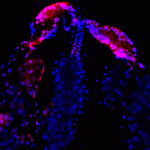Link to Pubmed [PMID] – 30478009
Link to DOI – 10.1016/j.ttbdis.2018.11.012
Ticks Tick Borne Dis 2019 Feb; 10(2): 328-335
Recent discoveries of tick-borne pathogens have raised public health concerns on tick-borne infectious diseases and emphasize the need to assess potential risks of unrecognized tick-borne pathogens. First, to determine the existence of tick-borne phleboviruses (TBPVs), genetic surveillance of phleboviruses in ticks was conducted mainly in Hokkaido, the northernmost island in Japan from 2013 to 2015. Genes of two TBPVs, previously reported as Mukawa virus (MKWV) and a newly identified relative of MKWV, Kuriyama virus (KURV), were detected and the viruses were isolated from Ixodes persulcatus collected in Hokkaido, but not in I. persulcatus collected from other areas of Japan. These viruses were phylogenetically and antigenically similar to each other. Next, to investigate the infection of MKWV in mammals, serum samples from wildlife captured in Hokkaido from 2007 to 2011 were used for serological screening. Neutralizing antibodies against MKWV were detected in both Yezo-deer (Cervus nippon yesoensis) (2/50) and raccoons (Procyon lotor) (16/64). However, no infectious MKWV was recovered from laboratory mice in experimental infections, though viral RNAs were detected in their tissues. Thus, MKWV and KURV may maintain tick-mammalian life cycles in Hokkaido, suggesting their potential as causative agents of tick-borne diseases in mammals.

